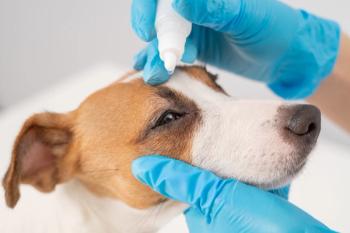
Reaching for a racing win with healthy horses and equine wellness
As equine veterinarians and advocates work to ensure their patient-athletes are receiving proper care, scientists work to advance therapies and better understand their physiology
A colt once destined for the Kentucky Derby is missing the big race with a condylar fracture of a front leg after his jockey noticed something wasn’t right. The racehorse, Tappan Street, experienced the injury at Churchill Downs, during a workout leading up to the prestigious event in Louisville, Kentucky, and was quickly taken for x-rays. Although the fracture isn’t expected to end Tappan Street’s career, it did put him out of the race.1
Veterinary professionals at the University of Florida (UF) in Gainesville said Tappan Street’s injury serves as a reminder that these “world-class athletes” need veterinary care to be ready for racing. “Similar to elite human athletes, equine athletes require a veritable team to keep them healthy, fit and competition ready. Veterinary medical care is an important part of this equation and can include everything from post-injury physical therapy to preventive protection against infectious diseases,” Sally DeNotta, DVM, PhD, a clinical associate professor of equine medicine and equine extension specialist at the UF College of Veterinary Medicine, said in a prepared statement.
In noting their similarities to elite human athletes, DeNotta also pointed out a key difference. “The difference is that they can’t tell us that something is sore. It’s up to us to develop better ways to ID (minor injuries) before they become a problem,” she said in a dvm360 interview.
Veterinary medicine is often on the front lines of the annual Kentucky Derby, running May 2-3, 2025, for the 151st time, at Churchill Downs. “This is a race with a lot of history in America,” DeNotta said.
At the Kentucky Derby and other horse races, the American Association of Equine Practitioners (AAEP) operates the high-profile
According to DeNotta, the Kentucky Horse Racing Commission also has veterinarians at Churchill Downs at all times during the Kentucky Derby. “The veterinarians conduct pre-race inspections to ensure horses are healthy and sound. Those veterinarians also administer any needed medication before the race in accordance with guidelines,” DeNotta said.
However, DeNotta said, although the Kentucky Derby is world-famous and has public support, there is also public concern for the health and welfare of equine athletes and the longevity of horse racing as an industry. “There is a big push nationally and globally to ensure the horses are kept as safe and healthy as possible,” she said.
Recent veterinary science initiatives have focused on catastrophic injuries, DeNotta said. There is work being done to identify and address injuries before they end careers as well as injury risk factors such as track conditions, how horses are exercised, and medications that are administered to equine athletes. “Our goal is to conduct research that supports the longevity of the sport by promoting the health and safety of the equine athletes that make it all possible,” DeNotta added.
Advancing the health of racehorses
DeNotta’s work includes an active study, “Effects of Repeated Furosemide Administration on Electrolyte Homeostasis and Bone Density in Healthy Adult Exercising Thoroughbreds,” for which she is principal investigator. The year-long research is funded by the Horseracing Integrity & Safety Commission (HISA).
Furosemide (Lasix) is an FDA-approved loop diuretic for human use3, but is also administered to horses to reduce bleeding in the lungs caused by exercise-induced pulmonary hemorrhage (EIPH). DeNotta said it may also help improve race performance. However, the effectiveness of furosemide for this use and the drug’s health effects on equine patients have come under public scrutiny.4
“If we better understand the long-term effects of commonly used medications, we can create science-based guidelines for how to safely use these medications to treat disease and injury while avoiding negative side effects,” DeNotta said.
In her study, 15 thoroughbred horses are exercising on a high-speed treadmill. Some are receiving furosemide for 3 months while others are administered a placebo. The 2 groups are then swapped. “The drug is known to prevent and treat EIPH. We are looking at the long-term effects of electrolytes,” DeNotta said.
A community effort in research
There are other studies focused on furosemide, which has been banned at Churchill Downs and other major racetracks for same-day use in horses under the age of 3 years. These include a large investigation ongoing in South Africa and another study on the same drug that is underway at Washington State University (WSU) in Pullman, and is also supported by HISA.4
The
“We hypothesize that our study will show horses that regularly get furosemide before racing have more races and longer careers than those that don’t,” Warwick Bayly, BVSc (Honors), PhD, MS, who is leading the study with Macarena Sanz, DVM, PhD, MS, said in a news release.5 “The results of this study are going to help guide the final decision on the future use of furosemide.”
Takeaway
Veterinarians can support the racing industry by supporting the horses that make it possible, DeNotta said. Veterinary scientists can help equine medicine practitioners better understand how medications affect racehorses by continuing to conduct research.
“It’s a team effort, keeping racehorses healthy,” DeNotta said. “The goal is to do the right thing for the horse.”
References
- Tappan Street out of Kentucky Derby with condylar fracture. Thoroughbred Daily News. April 26, 2025. May 2, 2025.
https://www.thoroughbreddailynews.com/tappan-street-out-of-kentucky-derby-with-condylar-fracture/ - AAEP On-Call program to provide horse health updates for Derby week racing. News release. American Association of Equine Practitioners.
https://aaep.org/post/aaep-on-call-program-to-provide-horse-health-updates-for-derby-week-racing/ - Khan TM, Patel R, Siddqui AH. Furosemide. May 8, 2023. Accessed May 2, 2025.
https://www.ncbi.nlm.nih.gov/books/NBK499921/ - McCafferty C. Researchers investigate effects of furosemide on racehorses. dvm360. April 24, 2024. Accessed May 2, 2025.
https://www.dvm360.com/view/researchers-investigate-effects-of-furosemide-on-racehorses - Rokyta D. WSU to study effect of controversial drug on racehorses. News release. Washington State University. April 23,2024. Accessed May 2, 2025.
https://news.wsu.edu/news/2024/04/23/wsu-to-study-effect-of-controversial-drug-on-racehorses/
Newsletter
From exam room tips to practice management insights, get trusted veterinary news delivered straight to your inbox—subscribe to dvm360.




